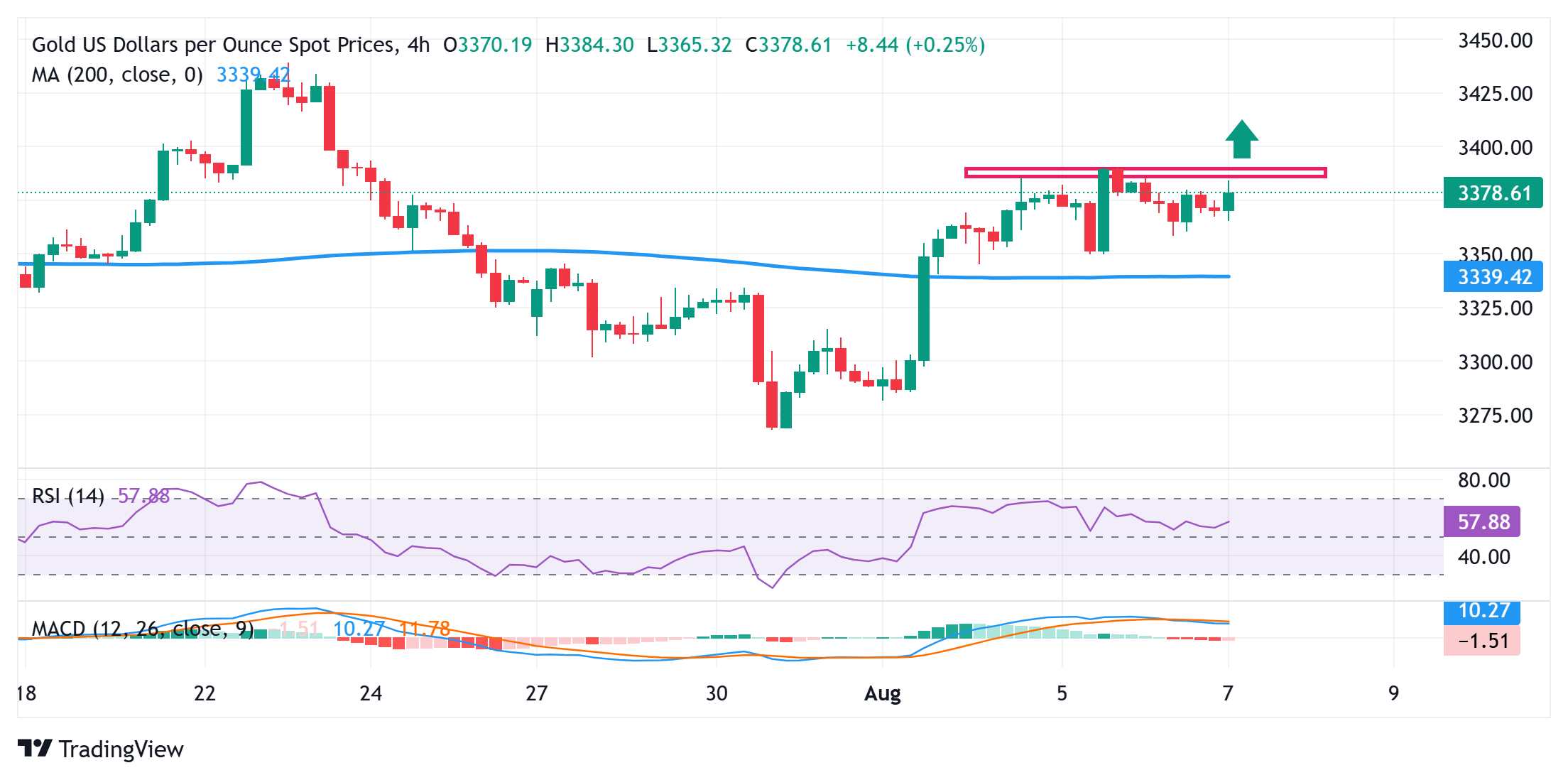Gold bulls look to seize control amid fresh trade jitters

- Gold price attracts some safe-haven flows in reaction to Trump’s fresh tariff threats.
- Rising bets for a Fed rate cut in September also benefit the non-yielding commodity.
- A modest USD recovery caps the precious metal amid a generally positive risk tone.
Gold price (XAU/USD) regains positive traction during the Asian session on Thursday and reverses the previous day’s modest losses as fresh trade concerns boost demand for traditional safe-haven assets. Apart from this, the growing acceptance that the US Federal Reserve (Fed) will resume its rate-cutting cycle in September turns out to be another factor lending support to the non-yielding yellow metal.
Meanwhile, the global risk sentiment seems rather unaffected by the latest trade-related developments. Adding to this, a modest rebound in the US Dollar (USD) from a one-week low touched on Wednesday could act as a headwind for the Gold price. This warrants caution before placing fresh bullish bets around the XAU/USD pair and positioning for any further upward move.
Daily Digest Market Movers: Gold price is backed by reviving safe-haven demand amid tariff jitters
- US President Donald Trump on Wednesday signed an executive order imposing an additional 25% tariff on Indian imports as “punishment” for buying oil from Russia, taking the total tariffs to 50%. Furthermore, reports suggest that Trump could impose an extra 15% tariff on all Japanese imports.
- Moreover, Trump had announced earlier this week that US tariffs on semiconductor and pharmaceutical imports would be unveiled within the next week or so. This revives concerns about the potential economic fallout from a global trade war and boosts the safe-haven Gold price on Thursday.
- Traders have been pricing in the possibility of more interest rate cuts than previously expected by the Federal Reserve this year. The bets were lifted by the weaker-than-expected US Nonfarm Payrolls report released last Friday and Tuesday’s disappointing US ISM Services PMI print.
- According to the CME Group’s FedWatch Tool, market participants see over a 90% chance that the US central bank will lower borrowing costs at the next monetary policy meeting in September. Moreover, the Fed is expected to deliver at least two 25-basis-point rate cuts by the end of this year.
- Dovish Fed expectations fail to assist the US Dollar in registering any meaningful recovery from a one-week low touched on Wednesday and further benefit the non-yielding yellow metal. However, a positive risk tone, tracking overnight gains on Wall Street, caps gains for the precious metal.
- Traders now look forward to the US Weekly Initial Jobless Claims, due for release later during the North American session. This, along with speeches from influential FOMC members, would drive the USD demand and produce short-term trading opportunities around the XAU/USD pair.
Gold price bulls need to wait for sustained move beyond $3,400 before positioning for any further gains
From a technical perspective, the commodity has been struggling to capitalize on the recent strength beyond the $3,380-3,385 region. Moreover, mixed oscillators on the daily chart warrant caution for the XAU/USD bulls. That said, this week’s bounce from the 200-period Simple Moving Average (SMA) on the 4-hour chart backs the case for a further appreciating move. Some follow-through buying beyond the $3,400 mark will reaffirm the constructive outlook and lift the Gold price to the $3,420-3,422 intermediate hurdle en route to the $3,434-3,435 supply zone. A strength move beyond the latter would set the stage for a move towards retesting the all-time peak, around the $3,500 psychological mark touched in April.
On the flip side, any corrective pullback might continue to find decent support near the $3,350 area. This is closely followed by the 200-period SMA on the 4-hour chart, which, if broken decisively, might prompt some technical selling and drag the Gold price to the $3,315 intermediate support en route to the $3,300 round figure. Acceptance below the latter would expose the $3,268 region, or a one-month low touched last week.
Tariffs FAQs
Tariffs are customs duties levied on certain merchandise imports or a category of products. Tariffs are designed to help local producers and manufacturers be more competitive in the market by providing a price advantage over similar goods that can be imported. Tariffs are widely used as tools of protectionism, along with trade barriers and import quotas.
Although tariffs and taxes both generate government revenue to fund public goods and services, they have several distinctions. Tariffs are prepaid at the port of entry, while taxes are paid at the time of purchase. Taxes are imposed on individual taxpayers and businesses, while tariffs are paid by importers.
There are two schools of thought among economists regarding the usage of tariffs. While some argue that tariffs are necessary to protect domestic industries and address trade imbalances, others see them as a harmful tool that could potentially drive prices higher over the long term and lead to a damaging trade war by encouraging tit-for-tat tariffs.
During the run-up to the presidential election in November 2024, Donald Trump made it clear that he intends to use tariffs to support the US economy and American producers. In 2024, Mexico, China and Canada accounted for 42% of total US imports. In this period, Mexico stood out as the top exporter with $466.6 billion, according to the US Census Bureau. Hence, Trump wants to focus on these three nations when imposing tariffs. He also plans to use the revenue generated through tariffs to lower personal income taxes.
